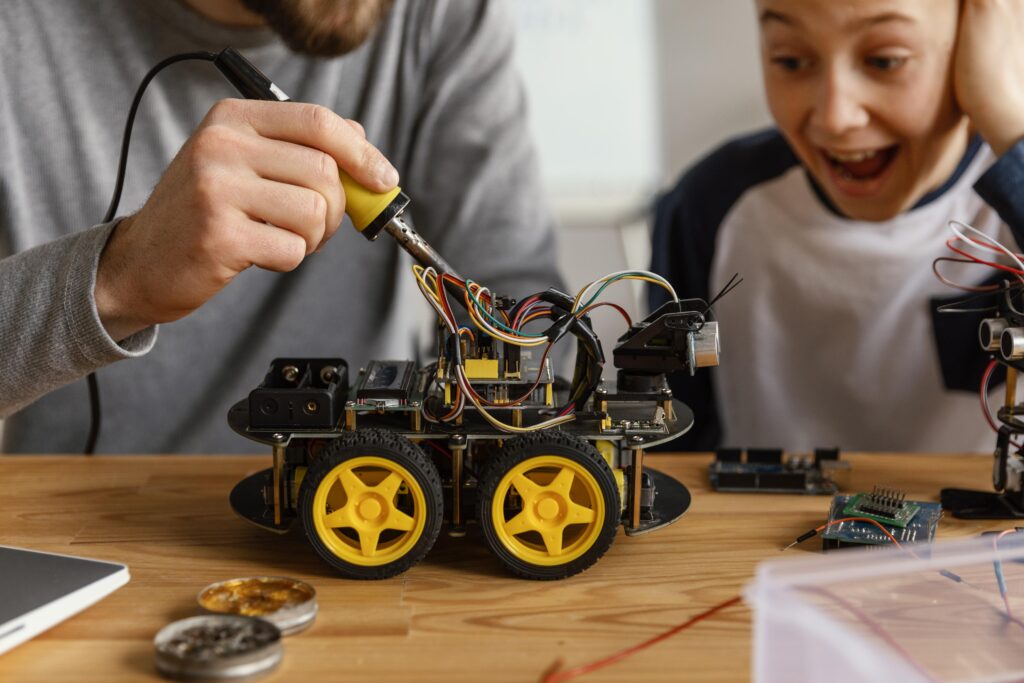admin
- Posted on
- No Comments
The emergence of the digital age has made a child’s academic performance in STEM (science, technology, engineering, and mathematics) very crucial. They might develop a negative attitude; however, this situation can be improved by informing them about robotics, a field filled with creativity, and involving them in this creative process. In the following blog, we plan to provide ways to get children into robotics and let them become future creative science researchers by motivating them.
Exploring Robotics with Kids
By learning robotics from an early age, we open a corridor to various vital aims, thus raising children’s power to realize their full potential. Students get to participate in practical activities, which become the basis of a deep comprehension of STEM concepts, a building block for future success in their careers. Robotics can develop critical thinking skills since students go through the process of overcoming challenges, looking for solutions, and fixing the programs that they are operating, therefore instilling persistence and adaptability.
Robotics comes with the advantage of combining creativity and innovation since the children use their ability to design and build their robots, which also means that their imaginations are ignited and they become more curious. The cooperative nature of group projects promotes teamwork and communication, consequently, developing relevant social skills and effectively interacting interpersonally. Fundamentally, getting robotics as a subject very early in life will not only help children acquire technical skills, but it will also shape a mindset that seeks knowledge, solves challenges, and finally keeps learning through life, which are the key qualities that will help them survive in the rapidly changing technological world.

Effective ways to introduce children to Robotics
Introducing children to robotics can be both fun and educational. Here are some effective ways to do it:
1. Start with hands-on kits
Provide the LEGO Mindstorms, VEX Robotics, or Makeblock Kits that are appropriate for beginners. Instructions for assembling basic robots typically accompany such kits, and those basic robots can help children learn the basics of robotics in a hands-on way.
2. Foster Creativity and Problem-Solving
In robotics education, creativity and problem-solving skills must be encouraged. Where kids have to design and build robots that can solve given problems or complete given tasks, this is an opportunity for them to take up open-ended challenges. In this way, children learn how to think critically by generating possible solutions for identified challenges, trying them out practically, hence making repetitions of the same processes such as in making robots.
3. Attend Workshops And Camps
Enrolling at robotics workshops or camps serves as a way for kids to get direct experience in learning about robotics as well as mentorship by qualified people. Throughout these courses, some specific tasks or assignments help students comprehend various ideas related to robots through teamwork with other schoolchildren.
4. Incorporate robotics into STEM education
If teachers add robotics projects to their science or math classes, they can strengthen academic concepts- it also presents a fascinating exploration area for them. Through STEM (Science, Technology, Engineering, and Mathematics) education, children are exposed to interdisciplinary learning opportunities when they incorporate the teaching of robots.
5. Introduce Programming
Robotics relies heavily on programming, which can easily be understood by kids with such playful interfaces as Blockly and Scratch. These programming languages are graphical and allow children to develop sequences of commands that would control the movements or actions of their robots, thus teaching them how to code at an early age.
How Robotics Sparks Creativity and Curiosity in Children
Robotics classes offer several advantages for students, Robotics for kids offers a variety of benefits, awakening interest and encouraging creativity from an early age.
Develops Critical Skills
This greatly aids in the enhancement of critical abilities among children, such as logical reasoning, attention to detail, and analytical thinking. This in turn helps them to understand how to break down complex problems into simpler ones that can be easily solved through certain steps or methods.
Encourages Creativity
Robots challenge children to be creative and think outside the box. This is because they can design any type of robot they want and then build it using different materials with varied functionalities in terms of shapes. Such kind of freedom allows them to experiment as much as possible, thereby sparking new ideas through innovation while at the same time imagining what has never been imagined before.
Enhances Problem-Solving Skills
Children who play robotics are exposed to real-world issues that call for creativity and design to find solutions. Here, they can learn how to identify problems, think of possible solutions, and put them to the test. Such activities will be useful in sharpening their abilities to solve problems and their resilience when faced with difficulties.
Enhances Technology Literacy
A deeper understanding of technology is acquired when children engage in robotics. With this knowledge, they are able to relate well to the world as far as programming, electronics, and mechanics are concerned and thus be in a position to fit in any society that is becoming more technological day in and day out.
What Is the Right Age to Introduce Robotics to Kids?
Your children aren’t very young to meet robots! Even if at this tender age you can make it so that they learn about simple machines during their pre-school years through things like making machines from building blocks that are in the form of toys and doing actual robot experiments for understanding.
If you want to give formal lessons on this subject, then wait until they are at least six years old, which is around the time most children enter elementary school. By that age, they would have acquired enough mental abilities to understand things like sequence and cause-effect relationships, among others.
Why choose Netcom Academy for your kids
Netcom Academy supports the belief that transforming children’s lives is possible through robotics education, which provides a complete course that focuses on experiential learning and application skills. It is during these lessons that kids get to think critically, solve problems logically, and become literate with technology, besides having room for creativity, self-esteem, and confidence building.
In addition, while involved in robot challenges and projects, students acquire knowledge in designing as well as constructing them; thereby making it an interesting way of learning science concepts related to engineering (STEM) deeply. The method used by Netcom Academy creates enthusiasm for acquiring knowledge throughout life among young people while at the same time enabling them to have what it takes to thrive in a world where technology steers everything.




